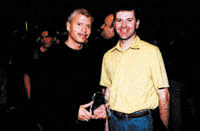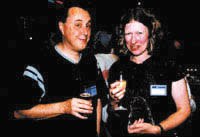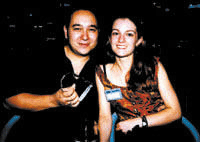Stephen Lynch visited Sydney's AEAF 2001 and found it to be a treasure trove of star talent presenting some of the most exciting effects coming to a screen near us soon.
Australia's visual effects community gathered at Sydney's Darling Harbor Convention Centre for the 6th Australian Effects and Animation Festival (AEAF) from February 26 28, 2001. While their motives for attending may have been as diversified as the festival's sessions, all visitors left with the same outcome: an invaluable experience and insight into the digital world at large.

"Our target audience consists of a broad range," stated festival chairman and editor of Digital Media World, Bill Dawes. "From students to craftspeople, animators, post-production professionals and technical experts within the industry." One of the major attractions for these attendees was the festival's line-up of guest speakers, which included a comprehensive gathering of local and international experience. "We got Hael Kobayashi from ILM to take Australian animators through the process of how to get a gig in this industry, and how to structure their careers," enthused Dawes. "For an Australian animator to get that sort of information from ILM is a once in a lifetime opportunity."
Apart from such overseas talent, the festival also provided the chance for two Australian animators, who have made their mark overseas, to partake in a sort of homecoming. Karen Ansel, who has worked on such films as The Mask, The Klumps and What Dreams May Come, pondered on the differences between working locally and in America. "Australia makes you flexible, because you really have to do everything. You're not slotted into one particular area, whereas in the U.S. you might be working on one sequence for 2 years. The plus side of working in the States was that there is a greater sharing of technological knowledge. In Australia, where the competition is tougher, people tend to hold onto their information a little bit."

Also returning home was James Rogers, the composite supervisor for the upcoming film Final Fantasy: The Spirits Within. Opening with clips from the full motion videos of the Final Fantasy games, James pointed out that, "If you ever question why Square decided to make a movie, looking at those videos should give you a fairly good idea of the logical progression." Following on with exclusive clips from the film, including never-before-seen behind the scenes footage, James gave an in-depth explanation of the process of creating a shot, from storyboard through to final composition. While the film had an average number of nine layers per shot, James shocked his audience when he recalled that the largest number of layers in one frame was 498. "That was a very bad day at the office."
Undoubtedly a draw-card for the festival, Final Fantasy's inclusion in the line-up, coupled with Mark Coleran's glimpse of his work on Tomb Raider, highlighted the relationship between film animation and video games animation. As Bill Dawes confirmed, "Previously that quality of animation was limited to the opening cinematics of major computer games. Then when you would go to the game play, where the animation has to be rendered in real-time by the graphics processor on the console or PC, [it wouldn't be as good]. Although it could not be of the quality of the pre-rendered sequence, I think we are now approaching that level with products like the X-Box and PS2. You are also seeing similar developments in the quality of animation produced for feature films. In terms of the presentation we saw of Final Fantasy and Shrek, we are close to photo-real capabilities, making animation of even two or three years ago appear second rate."

As someone who has worked on both film and video games, James Rogers believes the difference between the two mediums is minimal: "It's really in the way you approach the material. A game is on a small screen, a film is on a big screen, so your attention to detail and certain scenes is slightly shifted. Whereas on a film, you might fret about a freckle on the side of the actresses face, on a game you are less likely to worry about that." In fact, freckles and other blemishes are just some of the features that Square USA took pains to include in their 'actors' faces, resulting in a photo-realism that removes the 'china-doll' look which is so common in this type of animation. "It's funny, because the ironic thing is that it's difficult to make hair dirty," joked James. "You may be able to see single strands, but you hope that some of them clump together like they do in real people."

Day 3 of the festival was set aside for master classes, which were designed to teach attendees about specific areas of digital effects and animation. Michael Sarkis of Photon VFX, who conducted a class on motion control, explained that: "It shows people who may specialize in one area how different technologies and different companies are using the tools that are available in order to solve problems. There is a lot of technology on display here, but the fundamental thing is that it is a tool that allows people to be creative and achieve results. Being able to broaden your horizons and find how different things on the market can be linked together, or how you can use a tool in a way you might not have known before, this will come out in these master classes. People through their experience can show you how to use these tools to create images."
The same could be said of the festival as a whole. Enabling Australia's visual effects community to be exposed not only to the work being performed locally and internationally, but also to interact first hand with those responsible for that work, is a rare thing indeed. As Bill Dawes concluded, "When Laurence Treweek from Sony finished his session, he mentioned that he was currently recruiting for projects such as Stuart Little 2 and Harry Potter. He was promptly swamped by half the studio audience getting his card and email address and providing him with their CVs. The fact that we can provide that sort of opportunity is unique."

And the Winners Are...
On the final night of AEAF, the festival announced its winners in an upscale ceremony hosted at the Sydney Convention Centre in Darling Harbour. Boasting a record number of submissions and judges like ILM's Rob Coleman and Peter Giles, head of digital media at the Australian Film, Television and Radio School, Australian effects companies took home a number of prizes in categories filled with U.K. and U.S. competition.
Feature Film: The Grinch (Digital Domain) Games: Starship Troopers (Act III) Commercials, Animation: Gatorade "Raptor vs. Raptor" (ILM) Commercials, VFX: TDK "Evolve" (Digital Pictures) Music Videos: Bardot "I Should've Never Let You Go" (Momentum Animation) TV Series: Curse of the Talisman (Photon VFX) Titles, Idents & Stings: Hoyts "Experience" (GMD) Student: Intransit (Mike Daly) Web Animation: Westvale Road (Momentum Animation) Education & Training: A Neural Journey (Animated Biomedical Productions) Short Film: For the Birds (Pixar Animation Studios)
Stephen Lynch has written about the various aspects of filmmaking for books and magazines throughout Australia, England and America, as well as co-hosting Flicks, a weekly film review program.







